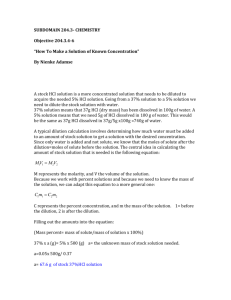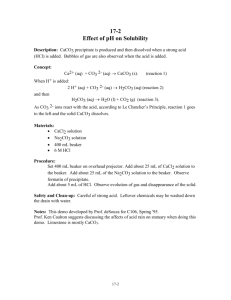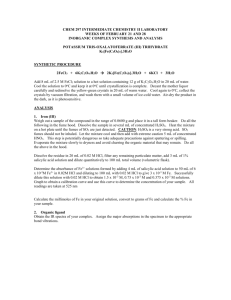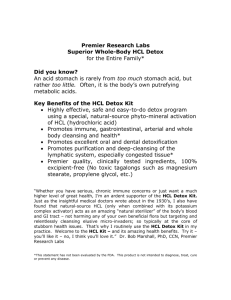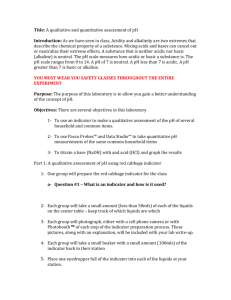Gen Chem Lab Exercise_Name
advertisement
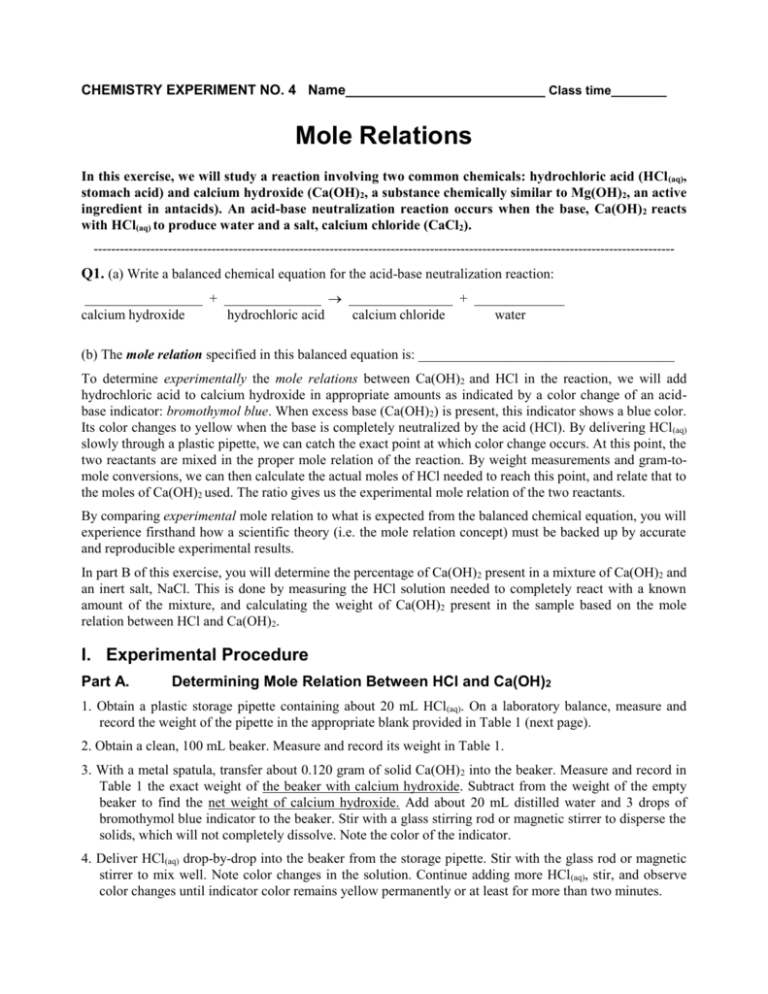
CHEMISTRY EXPERIMENT NO. 4 Name__________________________ Class time________ Mole Relations In this exercise, we will study a reaction involving two common chemicals: hydrochloric acid (HCl (aq), stomach acid) and calcium hydroxide (Ca(OH)2, a substance chemically similar to Mg(OH)2, an active ingredient in antacids). An acid-base neutralization reaction occurs when the base, Ca(OH)2 reacts with HCl(aq) to produce water and a salt, calcium chloride (CaCl2). ------------------------------------------------------------------------------------------------------------------------------------- Q1. (a) Write a balanced chemical equation for the acid-base neutralization reaction: _________________ + ______________ _______________ + _____________ calcium hydroxide hydrochloric acid calcium chloride water (b) The mole relation specified in this balanced equation is: _____________________________________ To determine experimentally the mole relations between Ca(OH)2 and HCl in the reaction, we will add hydrochloric acid to calcium hydroxide in appropriate amounts as indicated by a color change of an acidbase indicator: bromothymol blue. When excess base (Ca(OH)2) is present, this indicator shows a blue color. Its color changes to yellow when the base is completely neutralized by the acid (HCl). By delivering HCl (aq) slowly through a plastic pipette, we can catch the exact point at which color change occurs. At this point, the two reactants are mixed in the proper mole relation of the reaction. By weight measurements and gram-tomole conversions, we can then calculate the actual moles of HCl needed to reach this point, and relate that to the moles of Ca(OH)2 used. The ratio gives us the experimental mole relation of the two reactants. By comparing experimental mole relation to what is expected from the balanced chemical equation, you will experience firsthand how a scientific theory (i.e. the mole relation concept) must be backed up by accurate and reproducible experimental results. In part B of this exercise, you will determine the percentage of Ca(OH)2 present in a mixture of Ca(OH)2 and an inert salt, NaCl. This is done by measuring the HCl solution needed to completely react with a known amount of the mixture, and calculating the weight of Ca(OH)2 present in the sample based on the mole relation between HCl and Ca(OH)2. I. Experimental Procedure Part A. Determining Mole Relation Between HCl and Ca(OH)2 1. Obtain a plastic storage pipette containing about 20 mL HCl (aq). On a laboratory balance, measure and record the weight of the pipette in the appropriate blank provided in Table 1 (next page). 2. Obtain a clean, 100 mL beaker. Measure and record its weight in Table 1. 3. With a metal spatula, transfer about 0.120 gram of solid Ca(OH) 2 into the beaker. Measure and record in Table 1 the exact weight of the beaker with calcium hydroxide. Subtract from the weight of the empty beaker to find the net weight of calcium hydroxide. Add about 20 mL distilled water and 3 drops of bromothymol blue indicator to the beaker. Stir with a glass stirring rod or magnetic stirrer to disperse the solids, which will not completely dissolve. Note the color of the indicator. 4. Deliver HCl(aq) drop-by-drop into the beaker from the storage pipette. Stir with the glass rod or magnetic stirrer to mix well. Note color changes in the solution. Continue adding more HCl (aq), stir, and observe color changes until indicator color remains yellow permanently or at least for more than two minutes. 5. Weigh the storage pipette and record its weight in Table 1. Subtract from the original weight of this pipette to find the net weight of HCl(aq) delivered into the beaker. Table 1. Data And Calculations Initial weight of pipette (step 1) final weight of pipette (step 5) Formula Weight Ca(OH)2 _____________ g net weight of HCl(aq) delivered Formula Weight HCl ____________ g weight of empty beaker (step 2) weight of beaker and Ca(OH)2 (step 3) net weight of Ca(OH)2 Answer the following. Show calculations and pay attention to significant figures. Remember to report the unit of every numerical value. Q2. From the net weight of Ca(OH)2, calculate the mole(s) of Ca(OH)2 used in the reaction. (Net WtFormula Wt) ______________________________________________________________________________________ Q3. Given that 3.7 grams HCl are present in 100 grams of the HCl solution used in this experiment, calculate the grams of HCl added to the beaker. (Hint: Use the equality “100 g HCl (aq) = 3.7 g HCl” to convert net weight of HCl(aq) delivered into grams of HCl.) (grams present in 100 grams * Net wt HCl) ______________________________________________________________________________________ Q4. From the answer to Q3, calculate the mole(s) of HCl delivered into the beaker. (Q3formula wt acid) _____________________________________________________________________________________ Q5. (a) Compare the mole(s) of Ca(OH)2 calculated in Q2 to the mole(s) of HCl calculated in Q4. Find the nearest whole - number - ratio between the two values. (For example, to find the nearest whole -number - ratio of 0.88 and 0.91, you can divide 0.88 by 0.91= 0.96, which rounds to the nearest whole number:1 therefore, the nearest whole -number - ratio is 1:1.) (Q4Q2) _______________________________________________________________________________________ b) The ratio calculated in (a) is your experimental mole relation between Ca(OH) 2 and HCl. Is this experimental mole relation consistent with the mole relation from the balance equation in Q1? Explain. ___________________________________________________________________________ Part B. Determining the Percentage of Ca(OH)2 in a Mixture Put on safety goggles to protect your eyes! 1. Obtain a plastic storage pipette containing about 20 mL HCl (aq). On a laboratory balance, measure and record the weight of the pipette in the appropriate blank provided in Table 2. 2. Obtain a clean, 100 mL beaker. Measure and record its weight in Table 2. 3. Obtain a sample of Ca(OH)2 mixed with an unknown amount of NaCl(s), which does not react with HCl. Record the sample code in Table 2. Weigh 0.120 g of your sample into the beaker. Measure and record in Table 2 the exact weight of the beaker with the mixture. Subtract from the weight of the empty beaker to find the net weight of the mixture. Add about 20 mL distilled water and 3 drops of bromothymol blue indicator to the beaker. Stir with a glass stirring rod to disperse the solids, which will not completely dissolve. Note the color of the indicator. 4. Deliver HCl(aq) drop-by-drop into the beaker from the storage pipette. Stir with the glass rod to mix well. Note color changes in the solution. Continue adding more HCl(aq), stir, and observe color changes until indicator color remains yellow permanently or at least for more than two minutes. 5. Weigh the storage pipette and record its weight in Table 2. Subtract from the original weight of this pipette to find the net weight of HCl(aq) delivered into the beaker. 6. Deduction 0.0 %-Off 2 +/- Deduction 2.0 %-Off 4 +/- Deduction 4.0 %-Off 6 +/- Deduction %-Off 6.0 10 +/- or greater Table 2. Data And Calculations ( Sample Code:_________ ) Initial weight of HCl pipette (step 1) final weight of HCl pipette (step 5) net weight of HCl(aq) delivered weight of empty beaker (step 2) weight of beaker and mixture (step 3) net weight of mixture Answer the following questions. Show calculations and pay attention to significant figures. Remember to report the unit of every numerical value. Q6. Convert net weight of HCl(aq) delivered into grams of HCl based on information given in Q3 on page 2 of this handout. (grams present in 100 grams * Net wt HCl) _______________________________________________________________________________________ Q7. From the answer to Q6, calculate the moles of HCl delivered into the beaker. (Q6formula wt acid) _______________________________________________________________________________________ Q8. From the mole relation of the neutralization reaction between Ca(OH) 2 and HCl, calculate the moles of Ca(OH)2 present in your sample of mixture. (Q7coefficient) ______________________________________________________________________________________ Q9. From the moles of Ca(OH)2 found in Q8, calculate the grams of Ca(OH)2 present in your sample of mixture. (Q8*formula wt) ______________________________________________________________________________________ Q10. From the grams of Ca(OH)2 found in Q9, calculate the percentage of Ca(OH)2 present in your sample of mixture. (Q9net wt)*100 ______________________________________________________________________________________ II. Practical Applications Many who suffer from indigestion find relief by taking over-the-counter antacid tablets. This is because indigestion is often caused by an overproduction of stomach acid (HCl), and HCl can be neutralized through acid-base reactions. Though there are a variety of over-the-counter antacid formulations, most contain common mild bases such as sodium bicarbonate (NaHCO3), calcium carbonate (CaCO3), magnesium carbonate (MgCO3), aluminum hydroxide (Al(OH)3), and magnesium hydroxide (Mg(OH)2). Q11. Write a balanced chemical equation between each of the above named antacid ingredients and HCl. Find the mole relation between HCl and each base. Balanced chemical equation Mole relation between HCl and the antacid _____ HCl + _____ NaHCO3 ____ CO2 + ____ NaCl + _____ H2O _____ HCl + _____ MgCO3 ____ CO2 + ____ MgCl2 + _____ H2O _____ HCl + _____ CaCO3 ____ CO2 + ____ CaCl2 + _____ H2O _____ HCl + _____ Al(OH)3 ____ AlCl3 + _____ H2O _____ HCl + _____ Ca(OH)2 ____ CaCl2 + _____ H2O Q12. You are given three different brands of antacid. The first contains 100 mg calcium carbonate per tablet, second brand contains 60 mg Ca(OH)2, and third contains 75 mg aluminum hydroxide. Which brand offers the most “neutralizing power” per tablet? Show work and explain. Use the last 3 reactions listed in the above chart. Calculate either mass or moles, then compare values to answer the question. The best antacid will neutralize the most acid. mass of tablet (g) coefficien t of acid * formula wt of tablet (g/mol) coefficien t of tablet moles of acid (mol) mass of tablet (g) coefficien t of acid * * formula wt of acid (g/mol) formula wt of tablet (g/mol) coefficien t of tablet #1) Calculations for 100 mg calcium carbonate #2) Calculations for 60 mg Ca(OH)2 #3) Calculations for 75 mg aluminum hydroxide mass of acid (g)

